Building Design is shown around the eccentric London artist pair’s newly opened gallery.
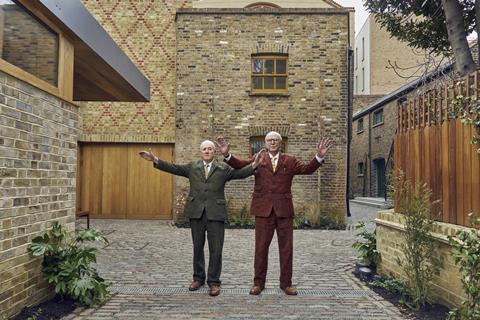
Gilbert and George are not backing down. After spending half a century as outsiders in liberal London, there would not be much point.
Conservative, anti-woke, pro-Brexit, they have somehow attained the niche position of being both the London art world’s enfants terrible and its grande dames. Now they have opened their own gallery, a move which further cements their position in the capital’s art establishment and, at the same time, in their trademark style, rebels against it.
That much is obvious before you even enter the new gallery space, which has been designed by London practice SIRS and opened its doors last week. The first thing you notice is the gate.
Turning the corner down a narrow side street off Brick Lane in Spitalfields, the east London area where the two artists have lived since the 1960s, you are confronted by a huge, elaborate tangle of wrought iron painted in a stately House of Commons green. The letters “G & G” are spelled out in two-metre tall Art Nouveau-esque swirls. Already you can sense arriving millennials beginning to bristle.
Then you notice the letters “CR” at the top, smaller but painted in gold. They stand for Charles Rex, King Charles III’s cypher.
Originally there was an “E” in place of the “C”, representing Charles’ mother, but this was put up two weeks before the late Queen’s death in September last year, prompting a hasty replacement. It is both a statement of the artists’ traditional British values and a very British kind of provocation.
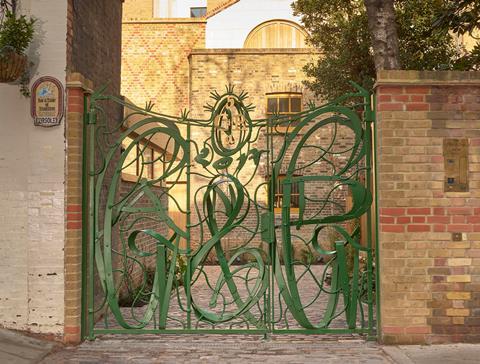
Examples of this love for tradition can be found throughout the site, an early 19th-century former brewery set in a picture-postcard East End courtyard. Building Design was shown round by lead architect and SIRS co-founder Manual Irsara, who was appointed to the project in 2015. It took a while to get planning approval, Irsara explains, because the site, wedged within a dense cluster of buildings, contained some 37 party walls shared with adjoining sites.
Beyond the gate there is a cobbled path leading to the entrance. Glittering in the early spring sunlight, it looks suspiciously clean. The cobbles, which had originally been set in concrete, were lifted out and individually washed. The concrete was then removed and the cobbles were put back, encased in gravel, the “traditional way of doing it”, Irsara says.
Ahead, there are two tall plants against the brewery building’s brick wall which were chosen by Gilbert and George to symbolise their pairing.
Gilbert Prousch and George Passmore first met at art school in 1967 while studying sculpture at Saint Martin’s School of Art. They later declared themselves to be “living sculptures”, and their relationship has been the focus of their work ever since.
Throughout the gallery there are references to the number two. “They are always playing with this dual aspect,” Irsara says.
“They have a very sharp eye for detail, choice of materials, design. You can talk to them at a very high level.” The motif informed many design decisions, from the two planks on the seats in the interior spaces, to the two rows of lights on the ceilings.
On the left side of the courtyard is a large overhanging canopy clad in English oak which leads into a standalone film room where visitors can watch the artists’ videos. It is a small space floored in Portland stone, a nod to Nicholas Hawksmoor’s Christ Church Spitalfields, which is a few minutes walk away.
The seats are clad in the same English oak as the exterior canopy, and the roof is Welsh slate. Opposite is the exterior wall of the site’s main new-build element, a large two-storey brick-faced block sandwiched between the brewery and neighbouring buildings.
The main gallery is entered from a small alley leading off the courtyard. Popping out of a far wall is a bay window painted a bright yellow ochre, a colour which has been used throughout the site from the interior lobby walls to the Apple Mac monitors behind the front desk.
On the outside wall of the brewery building, which was built between 1820 and 1835, are a number of cast-iron pattress plates. These structural reinforcements, often found on 18th and 19th-century brick buildings, are not in fact original but were installed by SIRS. They are attached to long iron rods, which prevent the walls from spreading under the building’s weight.
Inside is the lobby space, a welcoming room with low ceilings supported by iron columns, this time original. The rivets of these columns are capped with rubber covers which Irsara had specially made by a blacksmith – B&Q, it turns out, do not stock covers for early 19th-century rivets.
Irsara then leads the way into the project’s big reveal, the unexpectedly cavernous main gallery space. Turning the corner into this double-height space is a visual jolt, as the ceiling height triples to nearly six metres.
It is intended to be a “cinematic” transition, Irsara says, and the effect is similar to walking from the dark ground-floor lobby of the National Gallery’s Sainsbury Wing up to the sunlit upper floor.
The cosy yellow walls of the lobby are replaced by a clean art gallery white, framing a set of huge, fluorescent Gilbert and George artworks. Taken from the artists’ The Paradisical Pictures collection, they are a riot of oversized natural forms overlaid with unnatural colours. These are interspersed with images of the artists in various poses, or close-ups of their eyes in unsettling shades of red.
The feeling of warmth is not entirely left in the lobby. English oak has again been used for the floor, and this is extended for a detail which will shock the gallery sector – a skirting board. “It will surprise people in the gallery world,” Irsara says with delight.
It was a special request from Gilbert and George, partly to bring a feeling of homeliness to the space and, presumably, to ruffle some minimalist feathers. “They didn’t want a white cube, which is amusing because they are represented by the White Cube,” says Irsara. A Gilbert and George exhibition is currently on show at the White Cube in Mason’s Yard.
Upstairs there is a second gallery space beneath the pitched roof of the original brewery building, and there is a third in the basement. Both feature the same style of white walls, oak floors and skirting boards as the main ground floor space.
“There is a Gilbert and George touch on everything,” says Irsara. “That was their mission, to make a place which immerses visitors into their world.”
On the way out, Building Design chances upon an encounter with the artists themselves by the green gate which bears their initials. Gilbert, wearing an unusual conical fur hat, smiles as he passes by. “The brewery is no longer a brewery,” he says.


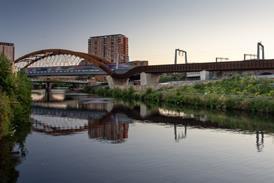
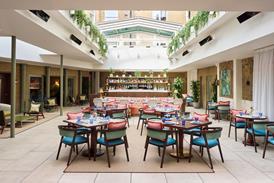





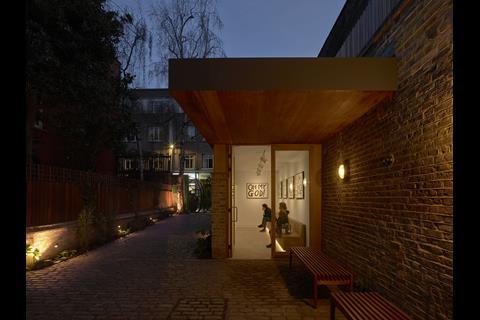
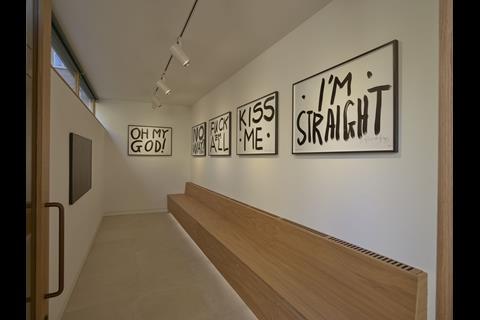
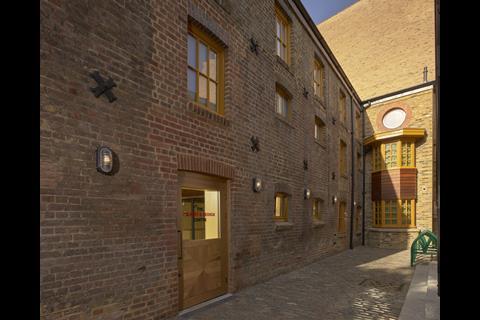
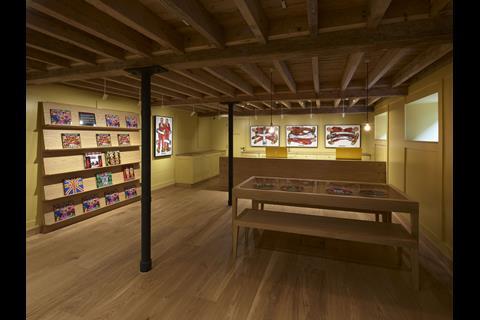

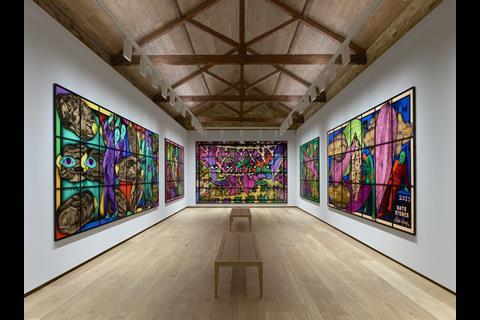

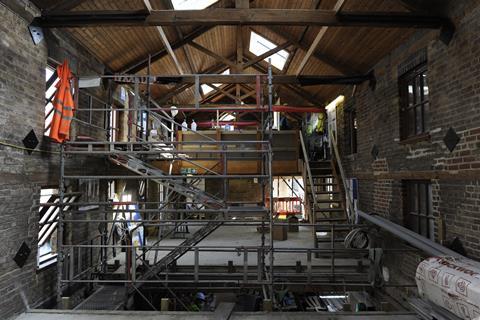
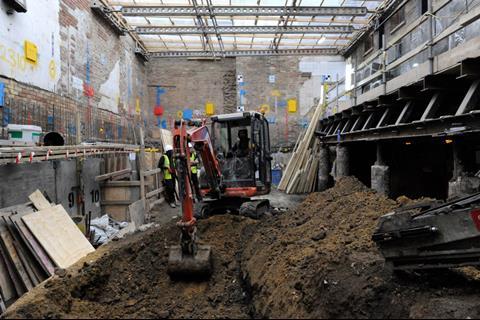
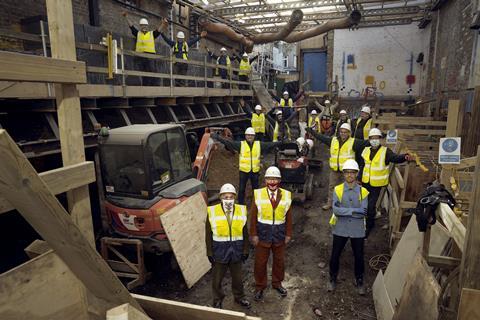

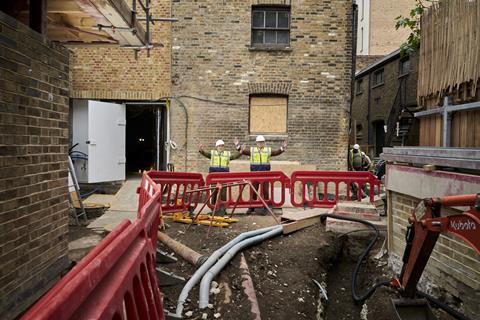







No comments yet